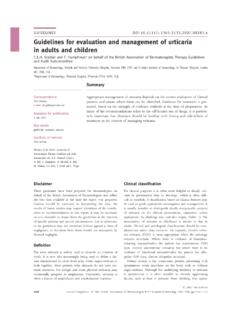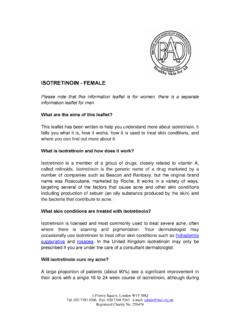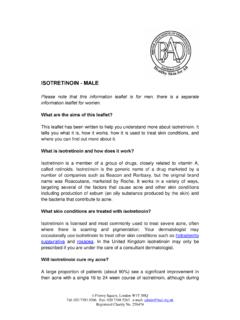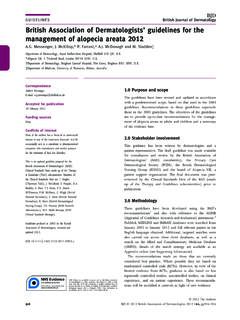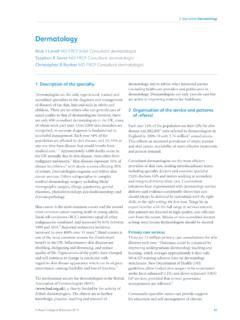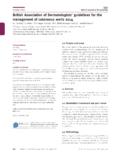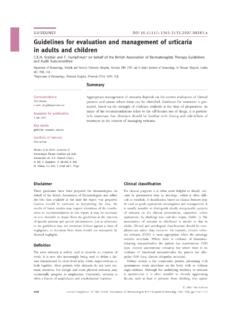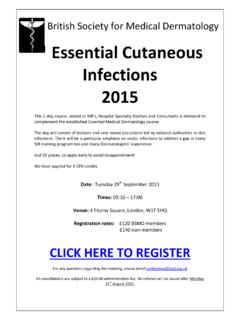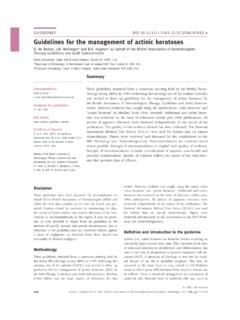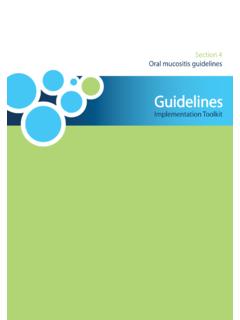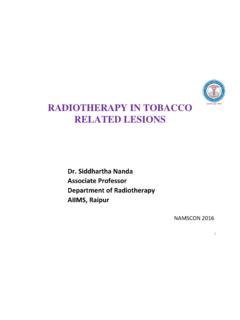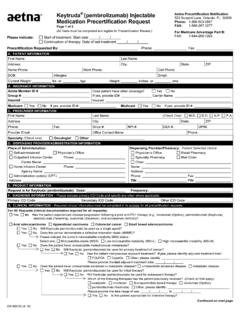Transcription of Guidelines for the management of basal cell …
1 GUIDELINESDOI for the management of basal cell Telfer, Colver* and Morton Dermatology Centre, Salford Royal Hospitals NHS Foundation Trust, Manchester M6 8HD, *Chesterfield Royal Hospital NHS Foundation Trust, Chesterfield, Stirling Royal Infirmary, Stirling, : for publication14 March 2008 Key wordsbasal cell carcinoma, Guidelines , managementConflicts of has received honoraria for speaking andhas organized educational events as well asconducted research during the past 5 yearsfrom for Galderma. He has also received travelsupport from 3M article represents a planned regular updating of the previous British Associa-tion of Dermatologists Guidelines for the management of basal cell Guidelines present evidence-based guidance for treatment, with identi-fication of the strength of evidence available at the time of preparation of theguidelines, and a brief overview of epidemiological aspects, diagnosis are several effective modalities available to treat basalcell carcinoma (BCC).
2 1,2 Guidelines aim to aid selection of themost appropriate treatment for individual patients. Carefulassessment of both the individual patient and certain tumour-specific factors are key to this is a slow-growing, locally invasive malignant epidermalskin tumour predominantly affecting caucasians. The tumourinfiltrates tissues in a three-dimensional fashion3through theirregular growth of subclinical finger-like outgrowths whichremain contiguous with the main tumour ,5 Metastasisis extremely rare6,7and morbidity results from local tissueinvasion and destruction particularly on the face, head andneck. Clinical appearances and morphology are diverse, andinclude nodular, cystic, superficial, morphoeic (sclerosing),keratotic and pigmented variants. Common histological sub-types include nodular (nBCC), superficial (sBCC) and pig-mented forms in addition to morphoeic, micronodular,infiltrative and basosquamous variants which are particularlyassociated with aggressive tissue invasion and or perineural invasion are features associated withthe most aggressive and aetiologyBCC is the most common cancer in Europe, Australia9and ,10and is showing a worldwide increase in data collection unfortunately means that accuratefigures for the incidence of BCC in the are difficult age shift in the population has been accompa-nied by an increase in the total number of skin cancers, and acontinued rise in tumour incidence in the has been pre-dicted up to the year most significant aetiological factors appear to be geneticpredisposition and exposure to ultraviolet areas of the head and neck are the most com-monly involved ,15 Sun exposure in childhood may beespecially age, male sex, fair skin typesI and II.
3 Immunosuppression and arsenic exposure are otherrecognized risk factors17and a high dietary fat intake may BCCs are a feature of basal cell naevus(Gorlin s) syndrome (BCNS).19 Following development of aBCC, patients are at significantly increased risk of developingsubsequent BCCs at other and investigationDermatologists can make a confident clinical diagnosis of BCCin most cases. Diagnostic accuracy is enhanced by good light-ing and magnification and the dermatoscope may be helpfulin some is indicated when clinical doubt existsor when patients are being referred for a subspecialty opinion,when the histological subtype of BCC may influence treatmentselection and prognosis8(Table1). The use of exfoliativecytology has been techniques such ascomputed tomography or magnetic resonance imaging 2008 The AuthorsJournal Compilation 2008 British Association of Dermatologists British Journal of Dermatology2008159,pp35 4835scanning are indicated in cases where bony involvement issuspected or where the tumour may have invaded majornerves,22the orbit23,24or the parotid tech-niques, such as ultrasound, spectroscopy and teraherz scan-ning, are of academic interest but currently have little or noproven clinical role.
4 Low-risk and high-risk tumours, patientfactors and treatment selectionThe likelihood of curing an individual BCC strongly correlateswith a number of definable prognostic factors (Table 1).These factors26,27should strongly influence both treatmentselection and the prognostic advice given to patients. Thepresence or absence of these prognostic factors allows clini-cians to assign individual lesions as being at low or high riskof recurrence following recent development of more effective topical and non-surgical therapies has increased the treatment options formany low-risk lesions, although surgery and radiotherapy(RT) remain the treatments of choice for the majority ofhigh-risk factors which may influence the choice oftreatment include general fitness, coexisting serious medicalconditions, and the use of antiplatelet or anticoagulant medi-cation. A conservative approach to asymptomatic, low-risklesions will prevent treatment causing more problems than thelesion itself.
5 Even when dealing with high-risk BCC aggressivemanagement may be inappropriate for certain patients, espe-cially the very elderly or those in poor general health, when apalliative rather than a curative treatment regimen may be inthe best interests of the , factors including patient choice, local availability ofspecialized services, together with the experience and pre-ferences of the specialist involved may influence wide range of different treatments has been described forthe management of BCC,29and both the British Association ofDermatologists (BAD)30and the American Academy of Derma-tology31have published professional Guidelines on theirappropriate use. Usually the aim of treatment is to eradicatethe tumour in a manner likely to result in a cosmetic outcomethat will be acceptable to the patient. Some techniques [ , curettage, RT, photodynamic therapy (PDT)] donot allow histological confirmation of tumour clearance.
6 Thesetechniques are generally used to treat low-risk tumours,although RT also has an important role in the management ofhigh-risk BCC. Surgical excision with either intraoperative orpostoperative histological assessment of the surgical margins iswidely used to treat both low- and high-risk BCC, and is gen-erally considered to have the lowest overall failure rate in rare advanced cases, where tumour hasinvaded facial bones or sinuses, major multidisciplinary cra-niofacial surgery may be are few randomized controlled studies comparing dif-ferent skin cancer treatments, and much of the published liter-ature on the treatment of BCC consists of open studies,some with low patient numbers and relatively short , the available treatments for BCC can be dividedinto surgical and nonsurgical techniques, with surgicaltechniques subdivided into two categories: excision techniquesExcision with predetermined marginsThe tumour is excised together with a variable margin of clin-ically normal surrounding tissue.
7 The peripheral and deep sur-gical margins of the excised tissue can be examinedhistologically using intraoperative frozen sections34or, morecommonly, using postoperative vertical sections taken fromformalin-fixed, paraffin-embedded approach maybe used with increasingly wide surgical margins for primary,incompletely excised and recurrent basal cell carcinomaSurgical excision is a highly effective treatment for primaryBCC,35,36with a recurrence rate of < 2% reported 5 years fol-lowing histologically complete excision in two different ,37 The overall cosmetic results are generally good,36particularly when excision and wound repair are performedby experienced practitioners. The use of curettage prior toexcision of primary BCC may increase the cure rate by moreaccurately defining the true borders of the ,39 The sizeof the peripheral and deep surgical margins should correlatewith the likelihood that subclinical tumour extensions exist(Table 1).
8 Although few data exist on the correct deep surgi-cal margin, as this will depend upon the local anatomy, exci-sion through subcutaneous fat is generally advisable. Studiesusing horizontal [Mohs micrographic surgery (MMS)] sectionswhich can accurately detect BCC at any part of the surgicalTable 1 Factors influencing prognosis of basal cell carcinomaTumour size (increasing size confers higher risk of recurrence)Tumour site (lesions on the central face, especially aroundthe eyes, nose, lips and ears, are at higher risk of recurrence)Definition of clinical margins (poorly defined lesions are athigher risk of recurrence)Histological subtype (certain subtypes confer higher risk ofrecurrence)Histological features of aggression (perineural and or perivascularinvolvement confers higher risk of recurrence)Failure of previous treatment (recurrent lesions are at higherrisk of further recurrence)Immunosuppression (possibly confers increased risk of recurrence)
9 2008 The AuthorsJournal Compilation 2008 British Association of Dermatologists British Journal of Dermatology2008159,pp35 4836 Guidelines for the management of basal cell carcinoma, suggest that excision of small (< 20 mm) well-definedlesions with a 3-mm peripheral surgical margin will clear thetumour in 85% of cases. A 4 5-mm peripheral margin willincrease the peripheral clearance rate to approximately 95%,indicating that approximately 5% of small, well-defined BCCsextend over 4 mm beyond their apparent clinical ,40,41 Morphoeic and large BCCs require wider surgicalmargins in order to maximize the chance of complete histo-logical resection. For primary morphoeic lesions, the rate ofcomplete excision with increasing peripheral surgical marginsis as follows: 3-mm margin, 66%; 5-mm margin, 82%;13 15-mm margin, > 95%.4 Standard vertical section process-ing of excision specimens allows the pathologist only toexamine representative areas of the peripheral and deep surgi-cal margins, and it has been estimated that at best 44% of theentire margin can be examined in this fashion, which maypartly explain why tumours which appeared to have beenfully excised do occasionally level:Surgical excision is a good treatment for primary BCC.
10 (Strength of recommendation A, quality of evidence I see Appendix 1).Incompletely excised basal cell carcinomaIncomplete excision, where one or more surgical margins areinvolved with (or extremely close to) tumour, has beenreported in 4 7%43and 7%44of cases reported from Britishplastic surgical units and 6 3%45,46in two retrospective studiesfrom Australia. This usually reflects the unpredictable extent ofsubclinical tumour spread beyond the apparent clinical mar-gins. However, other relevant factors associated with incom-plete excision include operator experience, the anatomical siteand histological subtype of the tumour43and the excision ofmultiple tumours during one the surgical margins are examined intraoperatively(excision under frozen section control, MMS), further resec-tion of any involved margins can take place prior to woundrepair. Using standard surgery, one approach to minimize therisk of incomplete excision is to excise tumours and delaywound repair until an urgent pathology report is received.
